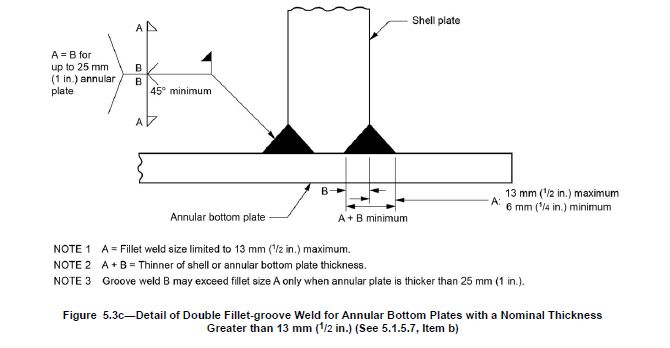Frank Zhang
Industrial
5.1.5.7 Shell-to-Bottom Fillet Welds
b) For annular plates with a nominal thickness greater than 13 mm (1/2 in.), the attachment welds shall be sized so
that either the legs of the fillet welds or the groove depth plus the leg of the fillet for a combined weld is of a size
equal to the annular-plate thickness (see Figure 5.3c), but shall not exceed the shell plate thickness.
How to understand this section? Does this section allow fillet weld only.
My understanding is:it has a choice: 1)-fillet weld only, 2) fillet+groove weld combine.
1- b) For annular plates with a nominal thickness greater than 13 mm (1/2 in.), the attachment welds shall be sized so
that the legs of the fillet welds is of a size equal to the annular-plate thickness (see Figure 5.3c), but shall not exceed the shell plate thickness.
2- b) For annular plates with a nominal thickness greater than 13 mm (1/2 in.), the attachment welds shall be sized so
that the groove depth plus the leg of the fillet for a combined weld is of a size equal to the annular-plate thickness (see Figure 5.3c), but shall not exceed the shell plate thickness.
is it right?
b) For annular plates with a nominal thickness greater than 13 mm (1/2 in.), the attachment welds shall be sized so
that either the legs of the fillet welds or the groove depth plus the leg of the fillet for a combined weld is of a size
equal to the annular-plate thickness (see Figure 5.3c), but shall not exceed the shell plate thickness.
How to understand this section? Does this section allow fillet weld only.
My understanding is:it has a choice: 1)-fillet weld only, 2) fillet+groove weld combine.
1- b) For annular plates with a nominal thickness greater than 13 mm (1/2 in.), the attachment welds shall be sized so
that the legs of the fillet welds is of a size equal to the annular-plate thickness (see Figure 5.3c), but shall not exceed the shell plate thickness.
2- b) For annular plates with a nominal thickness greater than 13 mm (1/2 in.), the attachment welds shall be sized so
that the groove depth plus the leg of the fillet for a combined weld is of a size equal to the annular-plate thickness (see Figure 5.3c), but shall not exceed the shell plate thickness.
is it right?

